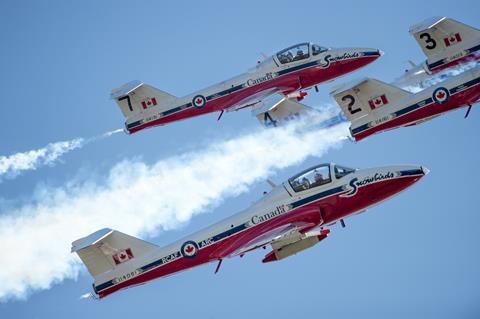The Royal Canadian Air Force’s (RCAF’s) Directorate of Flight Safety has concluded that the ingestion of a small bird into a Canadair CT-114 Tutor jet’s engine caused the aircraft to crash in May 2020.
The aircraft, Snowbird 11, had just taken off, and was about to begin an aerial demonstration near Kamloops, British Columbia. It suffered a compressor stall and a loss of thrust, says the investigator’s report, published on 29 March.

“Upon loss of power, the pilot initiated a climb straight ahead and then a turn back towards the airport. During this manoeuver, the aircraft entered into an aerodynamic stall and the pilot gave the order to abandon the aircraft,” says the Directorate of Flight Safety. “The pilot and passenger ejected from the aircraft at low altitude and in conditions that were outside safe ejection seat operation parameters. Neither the pilot nor the passenger had the requisite time for their parachutes to function as designed.”
The crash killed RCAF Captain Jenn Casey and injured Captain Richard MacDougall. The Snowbirds are the RCAF’s military aerobatic demonstration team.
The Directorate of Flight Safety’s report recommends “additional training for CT-114 aircrew to better prepare them for an engine failure after take-off in a low-level environment, clarify the command to eject, publish a directive to clarify how aircrew should prioritise an ejection-scenario near or over a populated area, and research potential options to stabilize the ejection seat from any tendency to pitch, roll, or yaw”.
“Snowbird 11’s power loss could not have come at a worse time – low altitude, low airspeed, proximity to another aircraft, and in the vicinity of a built-up area,” says Colonel John Alexander, director of flight safety with the RCAF. “This tragic accident reinforces the importance of continuous, situation-specific training to minimize reaction time in an emergency and the importance of a timely decision to eject.”
Nonetheless, Alexander adds that military flying comes with inherent risks.
“In emergency situations, pilots must make split-second decisions after quickly processing a lot of information, while at the same time dealing with high levels of stress, g-forces, and other challenging environmental factors in the cockpit,” he says.
The CT-114 was designed in the 1960s. To extend the lifespan of the Snowbirds’ aging fleet until 2030, the RCAF is undertaking the Tutor Life Extension Project, which will upgrade aircraft with new avionics and instrumentation, including a glass cockpit. The upgrades will also comply with Federal and Canadian Air Regulations. The RCAF says it also has a parallel project to improve the aircraft escape system with upgrades to the parachute and harness design.































